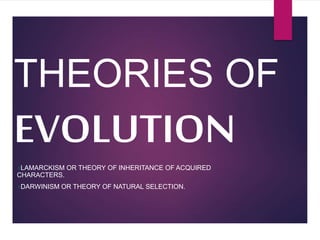
Theories of evolution
- 1. THEORIES OF EVOLUTION LAMARCKISM OR THEORY OF INHERITANCE OF ACQUIRED CHARACTERS. DARWINISM OR THEORY OF NATURAL SELECTION.
- 2. Lamarckism: It Is Also Called “Theory Of Inheritance Of Acquired Characters” And Was Proposed By A Great French Naturalist, Jean Baptiste De Lamarck In 1809 A.D. In His Famous Book “Philosphic Zoologique”. This Theory Is Based On The Comparison Between The Contemporary Species Of His Time To Fossil Records.
- 3. His theory is based on the inheritance of acquired characters which are defined as the changes (variations) developed in the body of an organism from normal characters, in response to the changes in environment, or in the functioning (use and disuse) of organs, in their own life time, to fulfill their new needs. Thus Lamarck stressed on adaptation as means of evolutionary modification.
- 4. A. Postulates of Lamarckism: Lamarckism is based on following four postulates: 1. New needs: Every living organism is found in some kind of environment. The changes in the environmental factors like light, temperature, medium, food, air etc. or migration of animal lead to the origin of new needs in the living organisms, especially animals. To fulfill these new needs, the living organisms have to exert special efforts like the changes in habits or behaviour.
- 5. 2. Use and disuse of organs: The new habits involve the greater use of certain organs to meet new needs, and the disuse or lesser use of certain other organs which are of no use in new conditions. This use and disuse of organs greatly affect the form, structure and functioning of the organs. 3. Inheritance of acquired characters: Lamarck believed that acquired characters are inheritable and are transmitted to the offsprings so that these are born fit to face the changed environmental conditions and the chances of their survival are increased.
- 6. 4. Speciation: Lamarck believed that in every generation, new characters are acquired and transmitted to next generation, so that new characters accumulate generation after generation. After a number of generations, a new species is formed. So according to Lamarck, an existing individual is the sum total of the characters acquired by a number of previous generations and the speciation is a gradual process. 1.
- 7. Darwinism (Theory of Natural Selection): Charles Darwin (1809- 1882 A.D.), an English naturalist, was the most dominant figure among the biologists of the 19th century. He made an extensive study of nature for over 20 years, especially in 1831-1836 when he went on a voyage on the famous ship “H.M.S. Beagle” and explored South America, the Galapagos Islands and other islands.
- 8. He collected the observations on animal distribution and the relationship between living and extinct animals. He found that existing living forms share similarities to varying degrees not only among themselves but also with the life forms that existed millions of years ago, some of which have become extinct.
- 9. B. POSTULATES OF DARWINISM: MAIN POSTULATES OF DARWINISM ARE: 1. Geometric increase. 2. Limited food and space. 3. Struggle for existence. 4. Variations. 5. Natural selection or Survival of the fittest. 6. Inheritance of useful variations. 7. Speciation.
- 10. 1. Geometric increase: According to Darwinism, the populations tend to multiply geometrically and the reproductive powers of living organisms (biotic potential) are much more than required to maintain their number e.g., 2. Limited food and space: Darwinism states that though a population tends to increase geometrically, the food increases only arithmetically. So two main limiting factors on the tremendous increase of a population are: limited food and space which together form the major part of carrying capacity of environment. These do not allow a population to grow indefinitely which are nearly stable in size except for seasonal fluctuation.
- 11. 3. Struggle for existence: Due to rapid multiplication of populations but limited food and space, there starts an everlasting competition between individuals having similar requirements. In this competition, every living organism desires to have an upper hand over others. This competition between living organisms for the basic needs of life like food, space, mate etc., is called struggle for existence which is of three types: (a) Intraspecific: Between the members of same species e.g. two dogs struggling for a piece of meat. (b) Interspecific: Between the members of different species e.g. between predator and prey. (c) Environmental or Extra specific: Between living organisms and adverse environmental factors like heat, cold, drought, flood, earthquakes, light etc.
- 12. 4. Variations: Variation is the law of nature. According to this law of nature, no two individuals except identical (monozygotic) twins are identical. This everlasting competition among the organisms has compelled them to change according to the conditions to utilize the natural resources and can survive successfully. Darwin stated that the variations are generally of two types— continuous variations or fluctuations and discontinuous variations. On the basis of their effect on the survival chances of living organisms, the variations may be neutral, harmful and useful.
- 13. 5. Natural selection or Survival of the fittest: Darwin stated that as many selects the individuals with desired characters in artificial selection; nature selects only those individuals out of the population which are with useful continuous variations and are best adapted to the environment while the less fit or unfit individuals are rejected by it. 6. Inheritance of useful variations: Darwin believed that the selected individuals pass their useful continuous variations to their offsprings so that they are born fit to the changed environment. 7. Speciation: According to Darwinism, useful variations appear in every generation and are inherited from one generation to another. So the useful variations go on accumulating and after a number of generations, the variations become so prominent that the individual turns into a new species. So according to Darwinism, evolution is a gradual process and speciation occurs by gradual changes in the existing species.